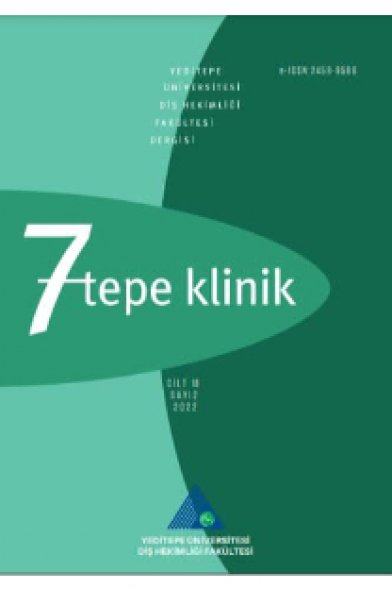Diş Hekimliği Fakültesi Öğrencilerinin Beden ve Organ Bağışına Bakışı
Attitudes of Dental Students Towards Body and Organ Donation
___
- Gunderman R, Giving our selves: the ethics of anatomical donation. Anat Sci Ed 2008; 1:217-219.
- Gallup Organization. National survey of organ and tissue donation attitudes and behaviors; 2005.
- Aybar L, Lopez J, Moxham B. Anatomists views on human body dissection and donation. Annals of Anatomy 196 2014; 376-386.
- Campbell CS. 1998. Religion and the body in medical research. Kennedy InstEthics J 8: 275-305.
- Daar AS. The body, the soul and organ donation beliefs of the major World religions. Nefrologia 1994; 14: 78-81.
- Gillman J. 1999. Religious perspectives on organ donation. Crit Care Nurs Q 22: 19-29.
- Hobeika M, Simon R, Malik R, Patchter L, Frangos S, Bholat O, Teperman S, Teperman L. U.S. Surgeon and medical student attitudes toward organ donation. The Journal of Trauma Injury, Infection, and Critical Care August 2009; Volume 67, Number 2.
- NHS Blood and Transplant: Hindu Dharma and Organ Donation http://www.organdonation.nhs.uk/ıkt/how_ to_become_a_donor/religious_perspectives/leaflets/ hindu_dharma_and_organ_donation. Jsp (30 July 2010, datelastaccessed)
- Organ Donation a Chiristian Duty. Church of England, 2007; http://www.cofe.anglican.org/news/pr9607.html
- Hassaballah AM. Definition of death, organ donation and interruption of treatment in Islam. Nphrol Dial Transplant 1996; 11: 964-965
- Oliver M, Ahmed A, Woywodt A. Donating in good faith or gettingin to trouble? Religion and organ donation revisited. World J Transplant 2012; 2(5):69-73.
- Boggiuı, Vistoli F, Chiaro MD et al. Kidney and pancreas transplants in jehovah’s witnesses: ethical and practical implications. TransplantProc 2004; 36: 601-602.
- Notzer N, Zisenwine D, Oz L, RakY. Overcoming the tension between scientific and religious views in teaching anatomical dissection: the Israeli experience. Clinical anatomy 2006; 19:442-447.
- Berkwitz SC. 2006. Buddhism in Sri Lanka: Practice, protest, and preservation. In: Berkwitz SC. Buddhism in Sri Lanka. Buddhism in World Cultures: comparative Perspectives. 1st Ed. Santa Barbara, CA: ABE-CLIO Inc. P 45-72.
- Chung CK, Ng CW, Li JY et al. Attitudes, knowledge, and actions with regard to organ donation among Hong Kong Med J 2008; 14: 278-285.
- Tontus H, Karabey M, Gurdal N. Survey of medicalstudents attitudes, religious beliefs, and knowledge of organ donation. Organs, Tissues anda Cells 2011;(14) 203-206.
- Ali NF, Qureshi A, Jilani BN, Zehra N. Knowledge and ethical perception regarding organ donation among medical students. BMC Medical Ethics. 2013; 14: 38.
- Ballala K, shetty A, Malpe SB. 2011. Knowledge, attitude, and practices regarding whole body donation among medical professionals in a hospital in India. Anat Sci Educ 4:142-150
- Goz F, Goz M, Erkan M. Knowledge and attitudes of medical, nursing, dentistry and health technician students towards organ donation: a pilot study. Journal of Clinical Nursing 2006; 15: 1371-1375.
- Asi J, Nikzad H, Taherian A, Atlasi M, Naderian H, Mousavi G, Kashani M, Omidi A. Cultural Acceptability and personal willingness of Iranian students toward cadaveric donation. Anat Sci Educ 2016.
- Alexander M, Marten M, Steward E, Serafin S, Strkalj G. Attitudes of Australian chiropratic students toward whole body donation. Anat Sci Educ 2014; 7:117-123.
- Cahill K, Ettarh R. Attitudes to cadaveric organ donation in Irish preclinical medical students. Anat Sci Educ 2011; 4:195-199.
- Woo K.T. Social and cultural aspects of organ donation in Asia. Ann Acad Med Singapore 1992; 421-427.
- Halou H, Chalkias A, Mystrioti D. Evaluation of the willingness for cadaveric donatiom in Greece: a populationbasedstudy. AnatSciEduc 2013; 6:48-55.
- Chakradhar K, Doshi D, Reddy B, Kulkarni S, Reddy M, Reddy S. Knowledge, attitude and practice regarding organ donation among Indian dental students. Intenational Journal of Organ Transplantation Medicine 2016; Vol.7(1).,
- ISSN: 2458-9586
- Yayın Aralığı: Yılda 3 Sayı
- Başlangıç: 2005
- Yayıncı: Yeditepe Üniversitesi Rektörlüğü
FİGEN EREN GİRAY, BAŞAK DURMUŞ, Ferhan ERTUĞRAL, MÜFERET ERGÜVEN, İlknur TANBOĞA
Premolar çekimli ve çekimsiz tedavinin yüz yumuşak dokuları üzerine etkilerinin incelenmesi
Uzamış stiloid proçes ile tonsillektomi ilişkisinin incelenmesi: Vaka Kontrol Çalışması
ZELİHA GONCA BEK KÜRKLÜ, Mehmet Emin TÜRKÖZ
Diş hekimliği öğrencilerinin pedodonti kliniğine ilişkin metaforik algıları
Burak BULDUR, Merve Nur AYDIN, Mevlüt KAYABAŞI, Çiğdem ÇUKURCU, Özge Nur GÜVENDİ
Rekürrent aftöz stomatitli hastalarda ağız sağlığına bağlı yaşam kalitesinin değerlendirilmesi
Esma KÜRKLÜ GÜRLEYEN, KADRİYE PEKER, GÜLSÜM AK
Metaphorical perceptions of dental students towards pediatric dentistry clinic
BURAK BULDUR, Çiğdem ÇUKURCU, Özge Nur GÜVENDİ, Mevlut KAYABASI, MERVE NUR AYDIN
Diş hekimliğinde günübirlik cerrahi anestezisi
Mohammed Ghazı Allan SALAHALDIN, BERKEM ATALAY
Zeynep Aslı GÜÇLÜ, Zekiye HİDAYET, DİLEK GÜNAY CANPOLAT, FATMA DOĞRUEL
